Fujitsu Tech Open House 2025: When AI Meets Quantum Computing
June 26, 2025
Japanese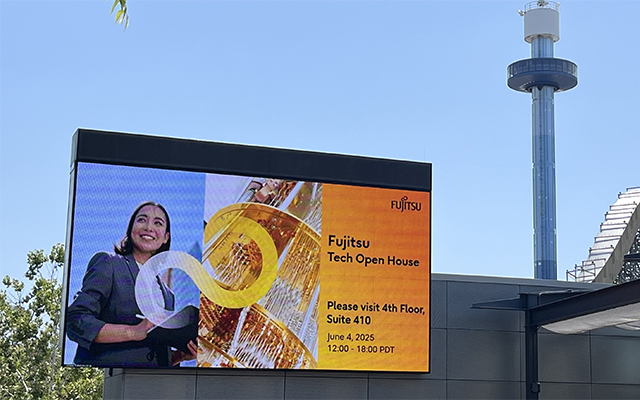
What happens when AI meets quantum computing? At Fujitsu, we are not just theorizing about it – we are building it. But the more intriguing question that emerged from our Tech Open House 2025 was: What happens when Fujitsu meets partners? The answer, as demonstrated on June 4th at our Santa Clara facility, is a convergence of breakthrough technologies and collaborative innovation that is reshaping the landscape of enterprise computing and scientific discovery.
Our Fujitsu Tech Open House 2025 showcased a bold vision for the future of AI, quantum computing, and open innovation, bringing together industry leaders, startups, and academic visionaries to explore groundbreaking technologies and collaborative partnerships. Through keynote presentations, live demonstrations, and an illuminating fireside chat with UC Berkeley's Professor Venkatesan Guruswami, we demonstrated how Fujitsu is evolving our technology strategy and embracing an open innovation model to tackle both business and societal challenges.
Fujitsu's Innovation Legacy and Vision
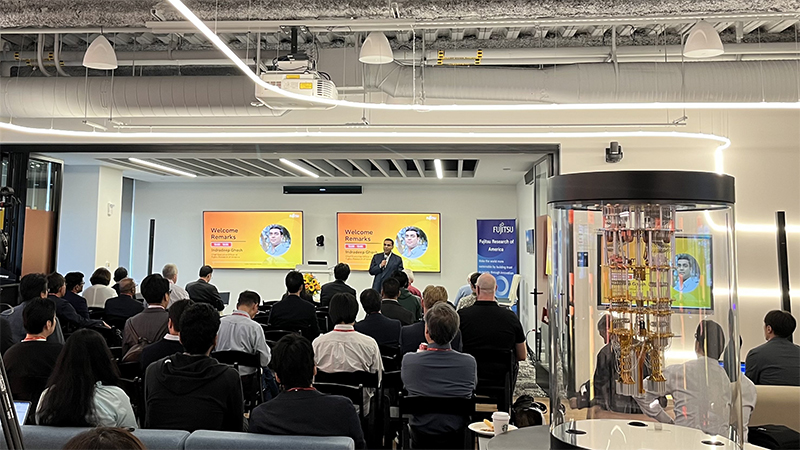
Founded in 1935 as a telecommunications company, Fujitsu has marked its 90th anniversary, with a research heritage that spans decades of technological breakthroughs. As Indradeep Ghosh, CEO of Fujitsu Research of America, emphasized in his opening remarks, “We try to realize our vision which is creating a sustainable world by promoting trust in society through our research.” This mission statement encapsulates not just our technological ambitions, but our commitment to addressing global challenges through innovation.
Fujitsu Research of America, established in 1993, has been conducting innovative research in Silicon Valley for more than 30 years. Our research network spans 20 global locations, with over 1,000 researchers and an annual budget exceeding $1 billion, positioning us at the forefront of technological breakthroughs in AI, quantum computing, computer architecture, and social digital twins. But what sets us apart is not just the scale of our research efforts – it is our commitment to translating these innovations into real-world solutions through strategic partnerships and collaborative development.
Revolutionizing Partnership Models and Open Innovation
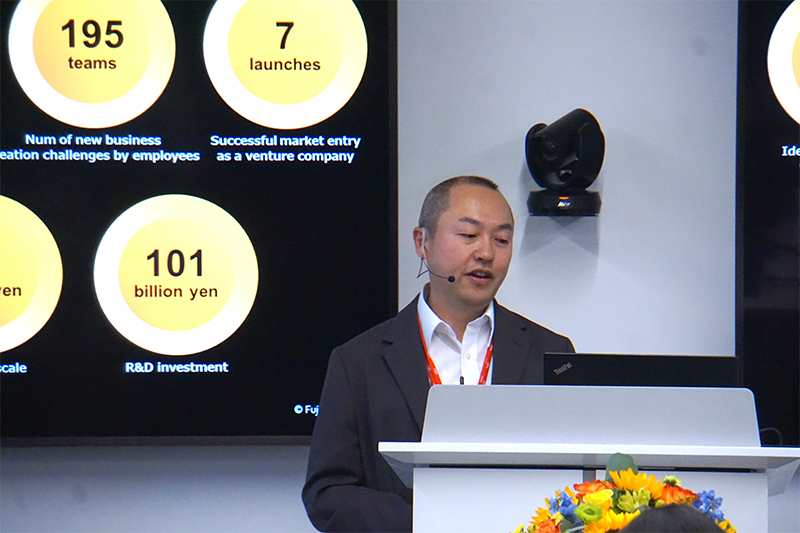
Takuto Komatsuki, Head of the Business Incubation Division at Fujitsu Limited, outlined our comprehensive approach to open innovation that goes far beyond traditional corporate partnerships. “We have done over 240 collaborations with startup companies,” Komatsuki revealed, highlighting the scale of our commitment to external innovation.
Our partnership strategy received a significant boost with the announcement of our second corporate venture capital fund of 15 billion yen (approximately 100 million USD), bringing our total investment capacity to 25 billion yen (172 million USD). This represents more than just financial commitment – it reflects our strategic approach to fostering innovation through impact investment in companies addressing social problems like carbon neutrality and circular economy initiatives.
The launch of our new Fujitsu Open Innovation Center in Fujitsu Uvance Kawasaki Tower represents a physical manifestation of our commitment to collaboration. This free-to-use facility provides startup partners with meeting spaces and collaboration areas, removing barriers to innovation and fostering the kind of close partnerships that drive breakthrough solutions.
Solving the GPU Utilization Crisis
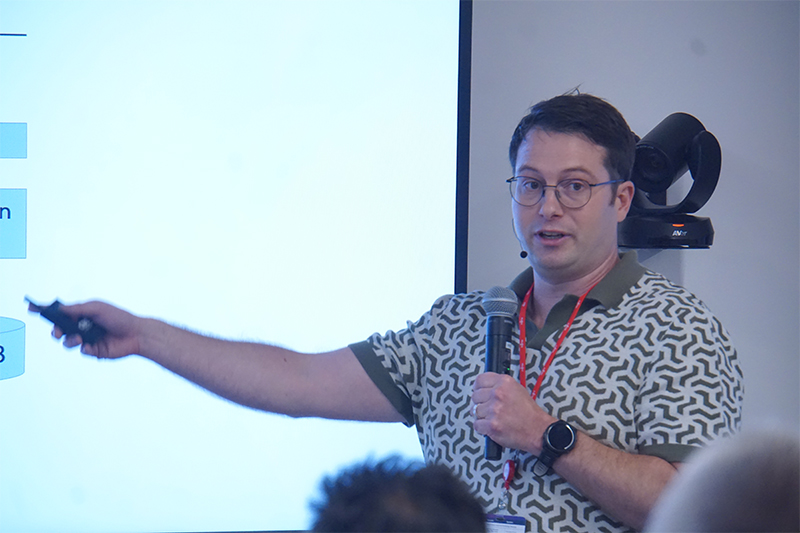
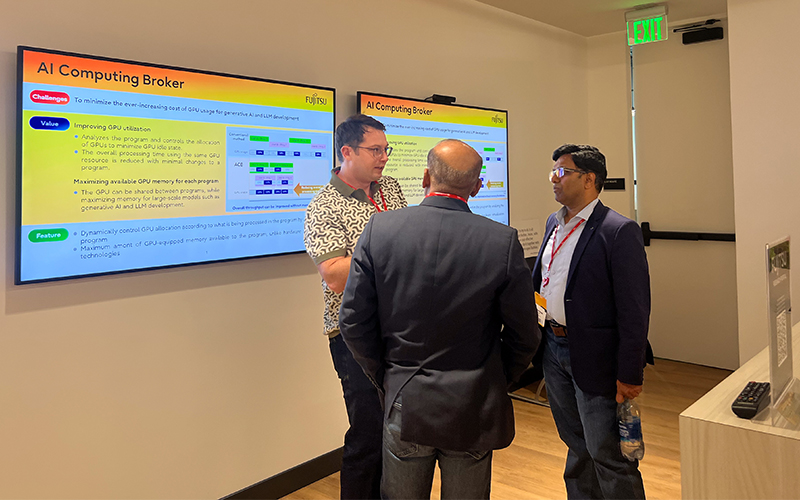
One of the most compelling demonstrations of our innovation-meets-partnership approach came from Matthias Loipersberger, Product Manager at Fujitsu Research of America, who presented our AI Computing Broker technology. Despite explosive growth in AI infrastructure spending – projected to reach $100 billion by 2027 – peak GPU utilization remains below 70% across enterprises.
Our AI Computing Broker represents a fundamental breakthrough through runtime-aware GPU allocation. “It basically monitors your AI framework and then allocates the GPU on a as needed basis,” Loipersberger explained. The technology dynamically hands over GPU resources between jobs, ensuring maximum efficiency while maintaining full memory access for active programs.
The impact is transformative: overall GPU efficiency increases while time to completion decreases. This innovation exemplifies our approach to solving real enterprise challenges through advanced technology, while the solution's compatibility with existing frameworks like PyTorch and TensorFlow demonstrates our commitment to practical, deployable solutions.
Accelerating Materials Discovery Through AI
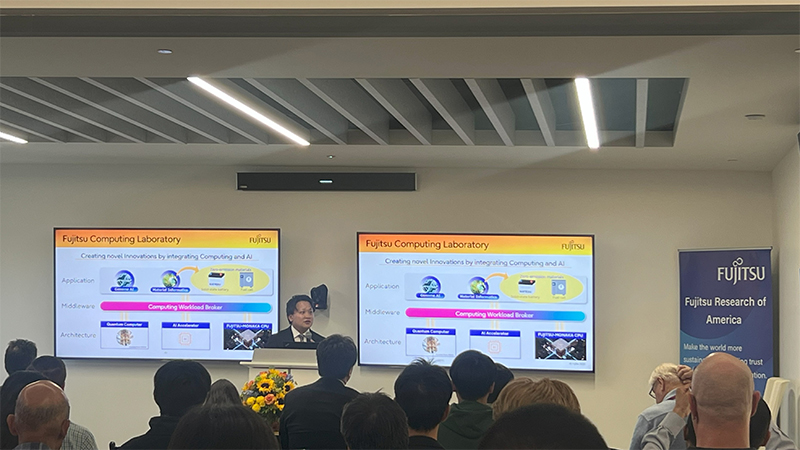
Yuto Iwasaki, Researcher from our Computing Laboratory in Japan, showcased how the convergence of AI and high-performance computing is revolutionizing materials science. “By using AI, specifically neural network potentials, we can make simulations up to 100 or 10,000 times faster,” Iwasaki explained, describing how this acceleration dramatically reduces product development cycles.
The practical applications are immediately relevant to enterprise customers. Iwasaki presented a case study involving polymer electrolyte membranes for fuel cells, demonstrating simulations of systems containing 20,000 atoms. The scalability means that we can evaluate many helpful materials by just increasing computing resources, opening new possibilities for rapid materials discovery and optimization.
Next-Generation Computing with FUJITSU-MONAKA
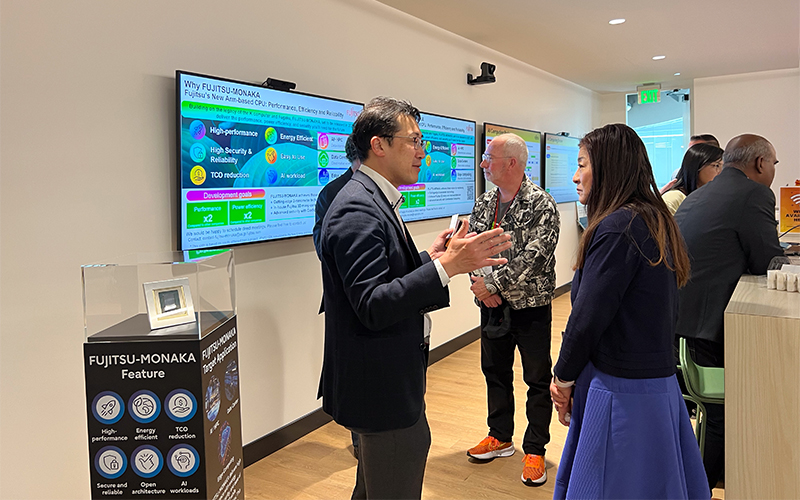
Hideo Senoo, Director of our Advanced Technology Division, presented our next-generation ARM-based processor, FUJITSU-MONAKA, which represents the culmination of decades of high-performance computing innovation. Fugaku's continued dominance in HPC benchmarks – maintaining number one rankings in Graph500 since 2020 – demonstrates the strength of our processor technology.
FUJITSU-MONAKA represents our evolution toward more general-purpose applications, bringing Fugaku-class performance and efficiency to enterprise data center environments. With data centers projected to consume 9% of global electricity by 2030, FUJITSU-MONAKA's energy-efficient design becomes critical for sustainable computing infrastructure. The processor's 512-bit SIMD capabilities for both HPC and AI workloads, combined with high bandwidth memory and scalable many-core architecture, position it as a transformative solution for enterprises seeking to balance performance with energy efficiency.
Quantum Computing: Building the Foundation for Tomorrow
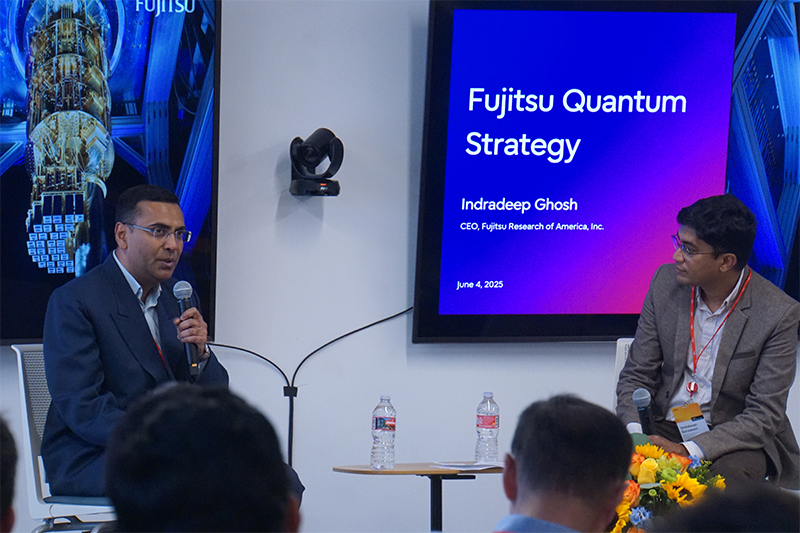
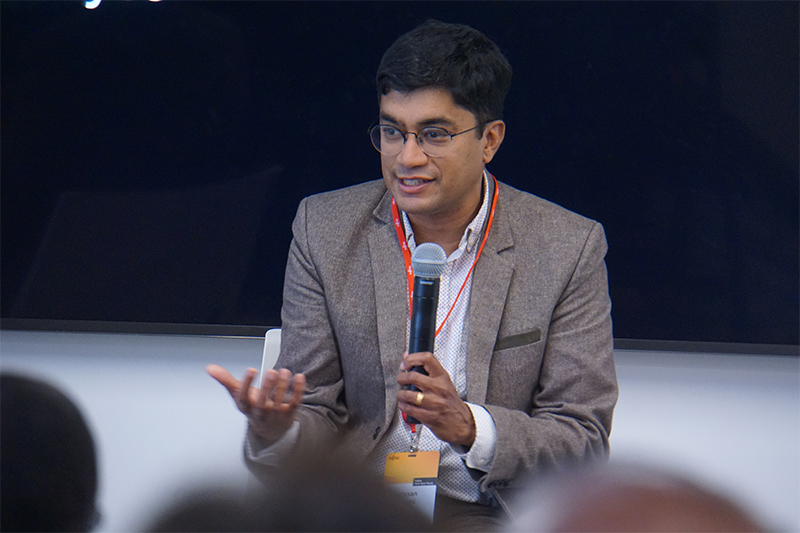
The highlight of our event was the fireside chat between our CEO, Indradeep Ghosh, and Professor Venkatesan Guruswami from UC Berkeley, focusing on quantum hardware and error correction. Ghosh outlined Fujitsu's comprehensive quantum strategy through a full-stack methodology spanning from quantum state control and device integration to quantum software and applications.
Our quantum achievements represent significant milestones in the field. We have successfully developed and deployed a 64-qubit quantum computer in collaboration with RIKEN, and our 256-qubit quantum computer – one of the world's largest-class quantum computers available to external users – became available in the first quarter of 2025.
Our diamond-spin quantum technology offers particular promise for scalability through a modular approach that allows for high-temperature operation above 1 Kelvin. Each module consists of electron spins and nuclear spins in diamond, with photonic links enabling communication between modules to create larger quantum computing systems.
Technology Showcase: Innovation in Action
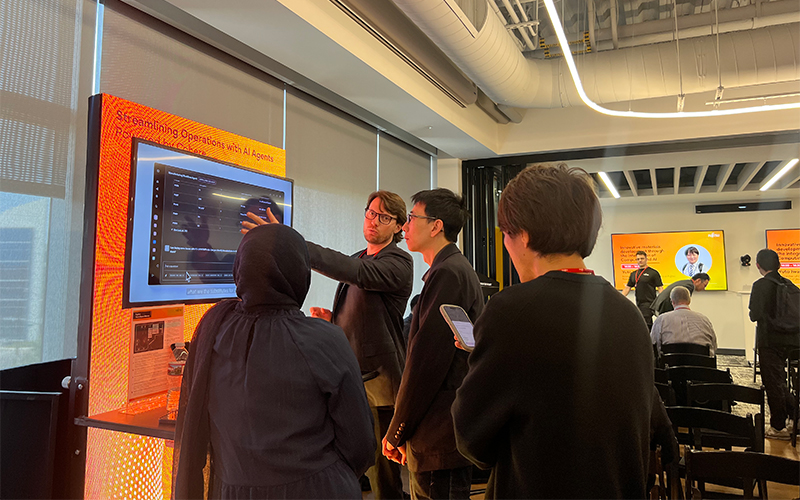
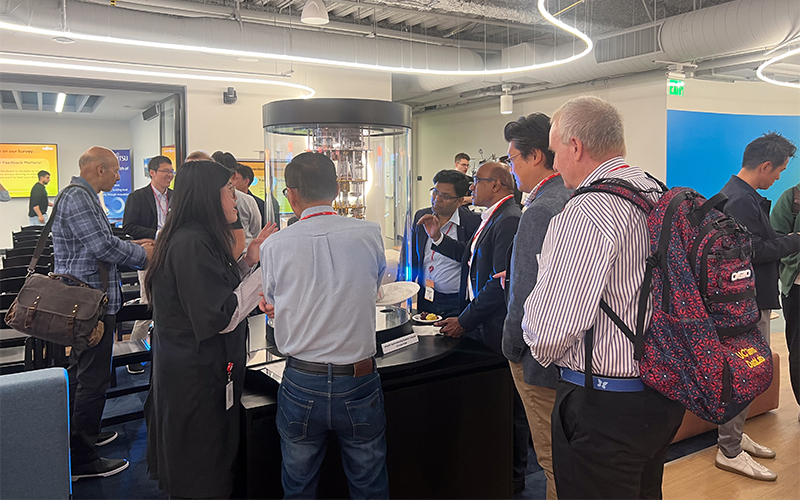
Our technology showcase provided firsthand exposure to the breadth of innovations emerging from our research labs and partnership collaborations. The domain-specialized large language models developed in collaboration with partners demonstrated practical AI applications that can “reduce the design time from 60 minutes to five minutes” for manufacturing applications, democratizing access to sophisticated design capabilities.
These showcase technologies illustrate our commitment to translating research breakthroughs into practical business solutions. Each technology represents not just a technical achievement, but a collaborative effort involving our research teams, industry partners, and startup collaborators who bring domain expertise and market insights to the development process.
The Future of Computing as a Service
Our vision extends beyond individual technologies to encompass a comprehensive “Computing as a Service” platform that integrates AI, high-performance computing, quantum-inspired technologies, and quantum computing into a unified offering. This platform approach enables enterprises to access cutting-edge computing capabilities without the complexity of managing diverse technology stacks.
The integration of our various technologies creates synergistic effects that amplify their individual capabilities. Our AI Computing Broker optimizes resource utilization, our materials simulation tools accelerate discovery processes, FUJITSU-MONAKA processors provide energy-efficient high-performance computing, and our quantum technologies tackle problems beyond the reach of classical computers.
Conclusion: Innovation Through Partnership
The Fujitsu Tech Open House 2025 demonstrated that the most compelling question is not simply “What happens when AI meets quantum computing?” but also “What happens when Fujitsu meets partners?” The answer is a multiplication of innovation potential that exceeds what any single organization could achieve alone.
Our technological breakthroughs – from the AI Computing Broker's solution to GPU utilization challenges, to FUJITSU-MONAKA's next-generation processing capabilities, to our advancing quantum computing systems – represent significant achievements. However, their true impact will be realized through the partnerships and collaborations that bring these technologies to bear on real-world challenges.
As we look toward the future, our commitment to open innovation, collaborative development, and partnership-driven growth positions us to address the complex challenges facing enterprises and society. We invite industry pioneers, academic visionaries, and innovation leaders to join us in exploring how our technologies can address your most pressing challenges and unlock new possibilities for growth and discovery. Together, we are not just building the future of computing – we are creating a regenerative, net positive world through trusted innovation and collaborative partnership.



